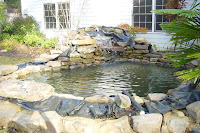Once you have determined the shape of your koi pond, you can measure it to determine the size of the pond liner that you will need. The standard rubber liner width is 20 feet but you can get widths up to 50 feet. The length can be anything you want up to the length of a roll which is usually 100 feet. It never hurts to buy a little extra. You will eventually find something else to use it for, like a waterfall.
When planning your water garden or koi pond, you'll want to choose a liner that allows you to create exactly the pond you desire. With such a wide variety of types and materials to choose from, you're sure to find the right match for your needs. Selection is largely determined by the size and shape of the pond, your budget and climate. Flexible liners offer extra versatility while preformed liners provide an established structure to work with. Concrete liners are also another option, though they require professional installation to prevent cracking. Once you decide on a pond size, you'll need to take measurements to ensure you bring home the right size liner.
But when deciding on a liner for your fish, make sure the one you are buying is safe for fish. You may be able to get a cheap rubber liner from a roofing contractor, as they may have liner left over from one of their jobs, but some cheap liners contain chemicals like an algaecide that may be harmful to fish and plants. Before you buy, check this out.
Types Of Pond Liners
There are several types of liner that you can choose for your koi pond, each offering it's own unique composition and in some cases, restrictive or limited use dependent upon the type of application required.1. Flexible Pond Liners
Liners are the most popular and cost effective way of creating a garden pond. They are available in a wide range of materials and sizes and allow you to make a pond of any shape.
Flexible liners are a lightweight plastic or rubber material that can be cut into any desired shape. They are ideal for building oversized or uniquely shaped ponds. Flexible liners can be used for both small and large ponds alike and are incredibly easy to install.
 |
| Flexible Pond Liner |
There are three general types, including EPDM (ethylene propylene diene monomer), PVC (polyvinyl chloride) and butyl rubber. These types are available in premeasured sheets and rolls. Most of these liners are manufactured in colors that reflect the natural look of a real pond, such as neutral earth tones of brown, green and black, which can give your pond a sense of depth.
2. Preformed Ponds Liner
Pre-formed ponds are made out of plastic or fibreglass, and are available in a wide range of shapes and sizes. They are extremely durable, and are popular with many, because once installed they have a smooth surface without creases.
 |
| Preformed Ponds Liner |
For definite shape and size, preformed liners are a good bet, although they often require more installation time because a hole must be excavated to match the liner design. Preformed liners are usually constructed of a strong plastic, such as HDPE (high-density polyethylene) or fiberglass and are easy to install. Although you can find liners that are as large as 12' across, the majority are smaller -- around 3' to 6' across and 18" deep.
3. Concrete Liner
This is the least popular method as it can be more expensive than other methods. Foundations must be solid and reinforced to prevent cracking if the subsoil shifts during the course of the year. Once rendered, the pool must be painted with at least two coats of a purpose made pond paint.
 |
| Concrete Liner |
Concrete ponds are made of a mix of cement, sand, gravel and water. Weather is a critical factor when mixing the concrete, as freezing conditions will make the concrete disintegrate before it cures





1 comments:
I really love to used this material in building my pond but unfortunately this is not available in my place, so we used trapal only and that is why we called our pond, trapond. you can see in one of the video here the pond we used is trapal http://giobelkoicenter.com/2015/12/19/breed-koi-fish/
Post a Comment